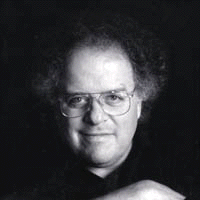Schubertabend with Kissin and Levine
F. Schubert, Music for Piano, Four Hands, Evgeny Kissin and James Levine, live concert at Carnegie Hall (released February 7, 2006) |
Bernard Holland's review (Schubert's Intimacy Endures Four Hands and 6,000 Ears, May 3) for the New York Times clarifies how Kissin and Levine compensated for the size of the halls where they played:
How does one convey the F minor Fantasy, one of Schubert's deepest and most mysterious pieces, in such a setting? Four hands on one keyboard is, to begin with, not the most transparent of sounds, but for two players sharing a piano bench in some private parlor it is the act, not the passive listening, that matters. No privacy here, however. And with no way to make Carnegie Hall smaller, one could at least make the music bigger. Keep Schubert's text intact, but use two pianos. Double the resonance; separate the players; lose the intimacy. Not ideal, but mutant Schubert played by such fine players was about the best anyone could do.It's true that Schubert wrote more than his share of memorable tunes, but the main theme of this fantasy is in a class by itself. How is it possible, with such economy (sol-sol-sol-do-sol repeats in how many permutations?), to make something so heart-breakingly beautiful? If Schubert had not brought back that gorgeous melody at the end of the third movement -- a device he used also in the D. 929 piano trio, which I heard played by the Vienna Trio on Sunday -- most players would insist on playing the whole first movement again anyway. (Schubert has you play that theme again twice.)
 |  |
The substantial program, over 70 minutes with two big encores, runs long enough that the concert is divided into two compact discs, priced nicely as a two-for-one. The main dish of the second half, the C major sonata ("Grand Duo," D. 812), is by itself just over 40 minutes long, a work of substance and weight, if not the greatest melodic genius. The biggest challenge of playing secondo, usually, is not overwhelming your partner's melody and pedaling the right amount (the player on the left in a four-hands duo typically controls the sustaining pedal, which requires a lot of intuition when you have to pedal while someone else is actually playing the melody). Kissin has such melodic strength that his high octaves ring out over Levine, almost no matter how much sound the latter gives.
Some of the greatest technical challenges come in the first of two encores. The Marche caractéristique No. 1 in C, D. 968b, is a romp of pulsating repeated notes, rumbling in the secondo part and incorporated in a most challenging way in primo's melodic material, which is child's play for Kissin. (In fact, at some point he may have played Liszt's transcription of this piece for one piano.) The Marche Militaire No. 1 in D, D. 733, has a circus quality about it, but the intervals do-sol-fi-sol always make me think of clowns. It's probably not what Schubert had in mind. The best way to experience this music is to play it yourself with a friend. Barring that, you could do worse than to listen to this recording, where it will likely sound much better.




















































6 comments:
I was there, and Kissin played primo in everything but the "Lebensstuerme."
Interesting. Thanks for that comment.
Charles... can you elaborate on how this is better than Britten/Richter? On paper, it would be unfathomable... with Richter being a superior pianist (although age may play into it: when was it recorded) than Kissin and Levine; probably a better musician than Kissin and with Britten a better musician than either Kissin or Levine and maybe even a better pianist than Kissin - if not quite as technique-driven... what are its flaws? Unrehearsed, bad sound, confluence of unfortunate flaws?
p.s. have you heard this CD?
Jens, I haven't heard that Pires/Castro recording, although I should have mentioned your review. As for the question about the Britten-Richter recording, I do not unfortunately own that recording, so I have only my memory of it to go on. The sound was not great, and the performance did not seem to add up to what the combination of players should have. It had strong moments, as you might expect, but overall I enjoyed the Kissin/Levine better.
Charles: i just came across this, at least a year or so after you posted it.
the transcription of Schubert you ascribe to liszt was actually by his student, karl tausig (whose transcriptions do tend to sound a lot like those of his teacher).
Also about the division of primo and secondo at the kissin-levine Schubert recital: Levine did play primo in the "Lebenssturme," but i'm pretty sure he also played primo (at the Boston concert, anyway) in something else -- though I don't remember what.
yours sincerely,
steve wigler
Post a Comment